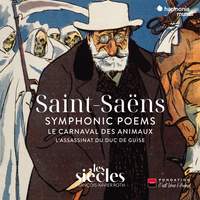Recording of the Week,
Saint-Saëns symphonic poems from François-Xavier Roth and Les Siècles
Le Rouet d’Omphale, coming on the heels of La Jeunesse d’Hercule, implies that the hero’s high-minded youthful forswearing of earthly pleasures in favour of virtue in the latter work has, shall we say, wavered somewhat in the ensuing time. The myth of Omphale involves a great deal of role-reversal, with Hercules compelled to play the role of a serving-girl to the titular queen, who in turn dons his famous lion-skin and assumes a traditionally ‘male’ dominance. The whole story is charged with erotic undertones, and not surprisingly has attracted artists down the years with the opportunity to explore its somewhat transgressive subject matter. Saint-Saëns in his age was no different, identifying the theme of Le Rouet as “feminine seduction, the triumphant struggle of weakness against strength”. The music is sensuous, luxurious and indulgent - though within the mould of a lively, flowing scherzo, and with further displays of wonderful instrumental and ensemble agility hinting at its origin as a work for two pianos.
The Danse macabre, Bacchanale from Samson et Dalila and Carnaval des animaux are undeniably the far better-known works - so much so that it’s difficult to hear them with ‘fresh’ ears. That being said, the astringent sounds of Death tuning up his violin (or failing to) are especially biting here, thanks no doubt to the 1863 instrument that François-Marie Drieux plays. Indeed, each instrument played is precisely listed in the booklet with either its date or that of the original of which it is a copy.
And it’s here that one of the album’s most unusual aspects rears its head, or heads - the use of a 1928 Pleyel double piano, a real pushmi-pullyu of an instrument that’s perfectly suited to the Carnaval’s part for piano duet. With the two pianists facing one another, it aids coordination in duet playing, and I wouldn’t be surprised if this is partly the reason that the wild asses in the third movement gallop around even faster than is usual.

Saint-Saëns’s score to the 1908 film L’Assassinat du duc de Guise is the first (or possibly second - opinions differ) film score ever composed, capturing the very earliest days of the nascent film industry. The film lasts only a quarter of an hour - so what might look like a handful of excerpts really is the entire soundtrack. I wholeheartedly agree with the contemporary critic who hailed this as a “little gem of symphonic music”; the chamber-orchestral scoring (fleshed out with piano and harmonium, and reminiscent of the Carnaval) allows for great colour in miniaturised form, with the third ‘tableau’ seeing some particularly gorgeous solo passages from the clarinet and flute. Saint-Saëns is an early master of the craft of synchronising music with on-screen action - perhaps the earliest - and it’s not unreasonable to see him as the forerunner of John Williams, Howard Shore and other contemporary composers for the big screen.
A reconstruction of the film with its soundtrack is available on YouTube, which you can watch below.
It’s undeniable that the three works lying at the centre of this album are the best-known and best-loved - but François-Xavier Roth and Les Siècles convincingly make the case for the others. The opportunity to discover what are effectively another four Saint-Saëns symphonic poems is a real joy - personally, the characterful L’Assassinat soundtrack is the one that I found myself returning to the most, but the three mythology-inspired works are no less compelling.
Les Siècles, François-Xavier Roth
Available Formats: 2 CDs, MP3, FLAC, Hi-Res FLAC




